

Emsi’s I-O model helps us measure the ripple effects of economic change in a region caused by adding or removing jobs, earnings, or sales. Because, as we know, business gains and losses don’t happen in a vacuum.
During the Great Recession in 2008 to 2009, full-service restaurants (sit-down) lost over 110,000 jobs (-2%). Limited-service restaurants (fast food) dropped slightly more than 50,000 jobs (-1%). People just didn’t have as much disposable income to spend on eating out.
But after the recession, when individuals began to recover financially, restaurants exploded. From 2010 to 2019, no industry added more jobs than Food Services and Drinking Places (NAICS 722)—over 2.5 million. That’s nearly 13% of all new jobs nationally. The food industry employed nearly 12 million people last year alone. It’s been the “golden age” of restaurants, as The Atlantic writer Derek Thompson described it.